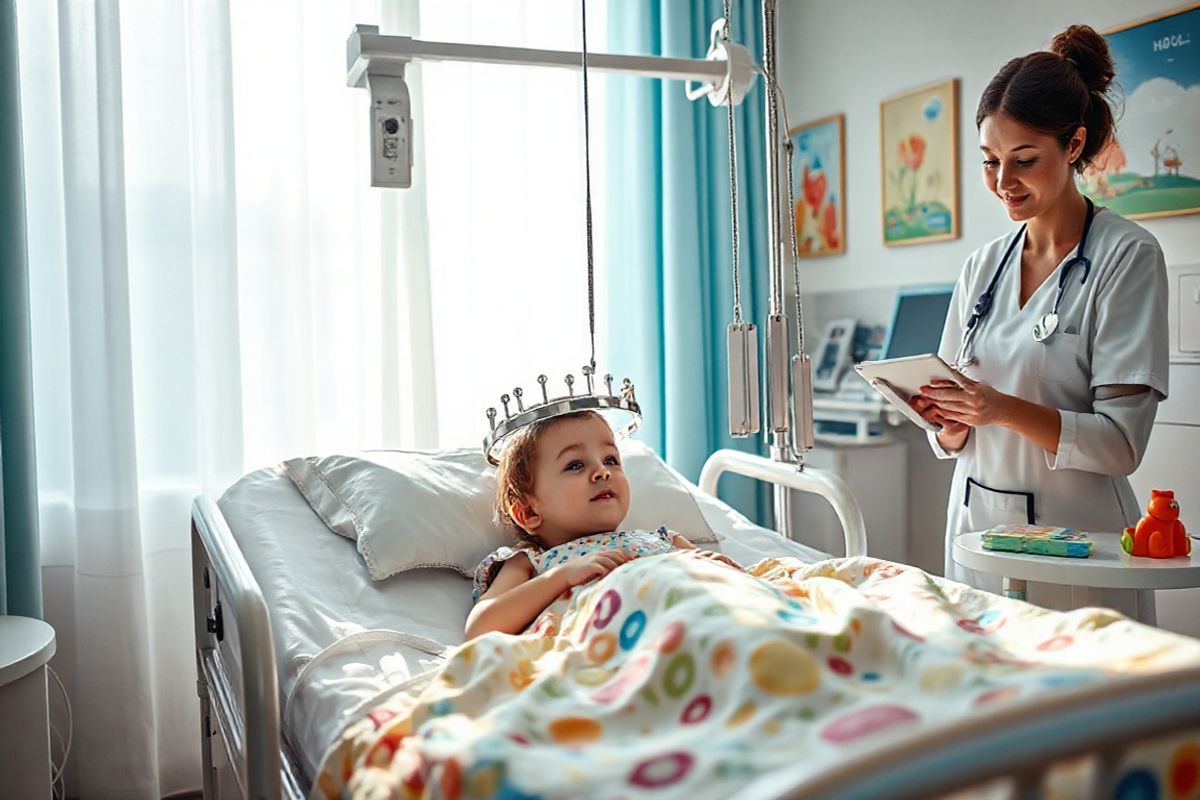Table of Contents
Understanding Halo Gravity Traction: An Overview of Its Purpose and Mechanism

Halo gravity traction (HGT) is a specialized medical technique primarily designed for the treatment of severe spinal deformities, such as scoliosis and kyphosis. This method involves the application of a metal halo device attached to the patient’s head, which is connected to a pulley system. The system uses weights to exert a gentle and continuous pulling force, effectively stretching the spine over time (Chaudhary & Agrawal, 2024). This gradual elongation helps to realign the vertebrae and reduce abnormal curves of the spine, making it a preparatory step for subsequent surgical interventions, such as spinal fusion (Children’s Healthcare of Atlanta, n.d.).
The halo device consists of a large metal ring that encircles the head and is fastened securely using pins inserted into the skull. The pulley system, which is affixed to the bed or a wheelchair, allows for the adjustment of weights applied to the halo. Over the course of several weeks, the weight can be incrementally increased, typically reaching up to 50% of the patient’s body weight. This method ensures that the spine is stretched slowly and carefully, minimizing the risk of damage to surrounding nerves and tissues (Halo-Gravity Traction, n.d.)
HGT is particularly beneficial for pediatric patients, as their spines are still developing, and the gradual correction can significantly reduce the severity of the curvature before a more invasive corrective surgery is performed (Children’s Healthcare of Atlanta, n.d.; Halo-Gravity Traction, n.d.).
Indications for Halo Gravity Traction: Which Spinal Conditions Benefit Most?

Halo gravity traction is indicated for various spinal deformities, particularly those that are severe, rigid, or associated with significant functional impairments. Conditions that typically benefit from this treatment include:
- Severe scoliosis: A sideways curvature of the spine that exceeds 45 degrees and does not respond to other forms of treatment.
- Kyphosis: An exaggerated forward rounding of the upper back, which can be particularly problematic when it exceeds 45 degrees.
- Cervical Instability: Conditions such as cervical kyphosis and basilar invagination that compromise the stability of the cervical spine (Halo-Gravity Traction, n.d.; Children’s Healthcare of Atlanta, n.d.).
- Neuromuscular Scoliosis: A curvature resulting from conditions like cerebral palsy or spina bifida that require careful preoperative management.
- Congenital Spine Deformities: Abnormalities present from birth that affect spinal alignment and stability.
The effectiveness of HGT lies in its ability to safely reduce the curvature of the spine, thereby improving the outcomes of subsequent surgeries and enhancing the overall quality of life for patients (Yale Medicine, n.d.).
The Benefits of Halo Gravity Traction: Transforming Treatment for Spinal Deformities
Halo gravity traction offers several benefits that transform the management of spinal deformities:
-
Non-Invasive Preparation for Surgery: HGT serves as a non-invasive method to prepare patients for more invasive surgical procedures, such as spinal fusion. By reducing the curvature before surgery, it minimizes the extent of correction needed during surgery, thereby lowering the risk of complications (Halo-Gravity Traction, n.d.).
-
Improved Respiratory Function: As the spine is gradually straightened, the thoracic cavity is expanded, which can lead to improved lung function and overall respiratory health, particularly in conditions where spinal curvature restricts lung development (Yale Medicine, n.d.).
-
Enhanced Patient Comfort: Many patients report that the process of traction alleviates some of the discomfort associated with their spinal deformities, allowing for better mobility and a more active lifestyle during treatment (Children’s Healthcare of Atlanta, n.d.; Halo-Gravity Traction, n.d.).
-
Multidisciplinary Support: The HGT process involves a multidisciplinary care team, including orthopedic surgeons, nurses, physical therapists, and child life specialists, who collectively work to ensure that the patient’s physical, emotional, and psychological needs are met throughout the treatment period (Halo-Gravity Traction, n.d.).
-
Customization of Treatment: The amount of weight applied and the duration of traction can be customized based on individual patient needs, allowing for a tailored approach that accommodates the specific characteristics of the spinal deformity (Yale Medicine, n.d.).
TablOverview of Conditions Benefitting from Halo Gravity Traction
| Condition | Description | Typical Age Group |
|---|---|---|
| Severe scoliosis | Curvature > 45 degrees | Pediatric |
| Kyphosis | Forward bending of the spine > 45 degrees | Pediatric/Adult |
| Cervical Instability | Instability in the cervical spine | Pediatric/Adult |
| Neuromuscular Scoliosis | Scoliosis due to neuromuscular diseases | Pediatric |
| Congenital Spine Deformities | Birth defects affecting spinal alignment | Pediatric |
Potential Complications of Halo Gravity Traction: What Patients Should Know
While halo gravity traction is generally safe, patients and caregivers should be aware of potential complications associated with its use:
-
Infection: One of the most common risks involves infection at the pin sites where the halo is attached to the skull. Careful monitoring and hygiene practices are essential to prevent infections (Yale Medicine, n.d.).
-
Pain and Discomfort: Patients may experience pain or discomfort, particularly at pin sites, especially after adjustments in the weight of the pulley system. This discomfort is typically managed with medications (Halo-Gravity Traction, n.d.).
-
Nerve Injury: Although rare, improper application or excessive weight may lead to temporary nerve injuries. Regular assessments by the care team help mitigate this risk (Children’s Healthcare of Atlanta, n.d.).
-
Psychological Impact: The prolonged hospital stay and the appearance of the halo device can affect a child’s emotional well-being. Support from child life specialists can help address these concerns (Yale Medicine, n.d.).
-
Need for Revision Surgery: In cases where the traction does not achieve the desired correction, additional surgical interventions may be necessary (Yale Medicine, n.d.).
TablPotential Complications of Halo Gravity Traction
| Complication | Description | Management |
|---|---|---|
| Infection | At pin sites | Antibiotic treatment |
| Pain and Discomfort | At pin sites | Pain medication |
| Nerve Injury | Rare, usually temporary | Regular neurological checks |
| Psychological Impact | Emotional stress due to treatment | Psychological support |
| Need for Revision Surgery | If desired correction is not achieved | Additional surgical intervention |
The Future of Halo Gravity Traction in Spinal Care: Innovations and Research Directions
The future of halo gravity traction in spinal care is promising, with ongoing research and innovations aimed at improving its efficacy and patient experience. Some of the potential advancements include:
-
Enhanced Imaging Techniques: The integration of advanced imaging technologies, such as MRI and CT scans, will provide better assessments of spinal alignment and the effectiveness of traction, allowing for more informed adjustments during treatment (MaineHealth, n.d.).
-
Smart Traction Devices: Future traction devices may incorporate smart technology to monitor patient responses in real-time, adjusting the weight and tension automatically based on feedback from sensors (UT Southwestern Medical Center, n.d.).
-
Expanded Research on Outcomes: Continued studies are vital to better understand the long-term outcomes associated with HGT, particularly its impact on spinal growth, respiratory function, and overall quality of life in patients undergoing treatment (Chaudhary & Agrawal, 2024).
-
Multidisciplinary Approaches: The collaboration between orthopedic surgeons, pediatricians, physical therapists, and psychologists will be key in enhancing the comprehensive care model for patients undergoing halo gravity traction (UT Southwestern Medical Center, n.d.).
-
Patient Education Programs: Developing robust educational programs for families and patients will improve understanding and compliance, ensuring that patients can navigate the complexities of their treatment effectively (MaineHealth, n.d.).
FAQ Section
What is halo gravity traction?
Halo gravity traction is a medical treatment that uses a halo device and pulley system to gently stretch the spine, primarily used for severe spinal deformities.
Who is a candidate for halo gravity traction?
Candidates typically include children and adolescents with severe scoliosis, kyphosis, or other spinal deformities that require correction prior to surgery.
How long do patients stay in halo gravity traction?
Patients usually remain in traction for about 3 to 8 weeks, depending on their specific condition and treatment goals.
Is halo gravity traction painful?
Patients may experience some discomfort, particularly around the pin sites; however, pain management is typically effective.
What happens after halo gravity traction?
Once the desired spinal alignment is achieved, patients may undergo a surgical procedure, such as spinal fusion, to stabilize the spine permanently.
References
- Children’s Healthcare of Atlanta. (n.d.). Halo-gravity traction. Retrieved from https://www.choa.org/medical-services/orthopedics/scoliosis-and-spine-program/halo-gravity-traction
- Halo-Gravity Traction. (n.d.). Yale Medicine. Retrieved from https://www.yalemedicine.org/conditions/halo-gravity-traction
- Chaudhary, F., & Agrawal, D. K. (2024). Anesthesia-induced developmental neurotoxicity in pediatric population. Journal of Surgery and Research. Retrieved from https://doi.org/10.26502/jsr.10020400
- MaineHealth. (n.d.). Spine disorders & injuries. Retrieved from https://www.mainehealth.org/care-services/brain-back-nervous-system-care-neurology/spine-disorders-injuries
- UT Southwestern Medical Center. (n.d.). Advanced treatment for spine disorders. Retrieved from https://utswmed.org/conditions-treatments/spine-disorders/
- PLoS Biology. (2024). Local changes in potassium ions regulate input integration in active dendrites. Retrieved from https://doi.org/10.1371/journal.pbio.3002935
- Quality of nursing care in pain management in orthopedic surgical patients: a scoping review. (2024). Retrieved from https://pubmed.ncbi.nlm.nih.gov/11649067/
- Journal of Surgery and Research. (2024). Anesthesia-induced developmental neurotoxicity in pediatric population. Retrieved from https://doi.org/10.26502/jsr.10020400











